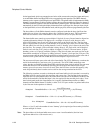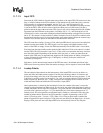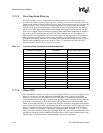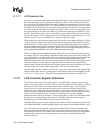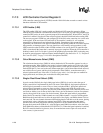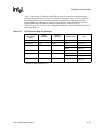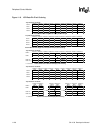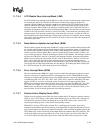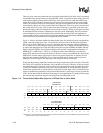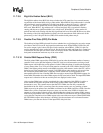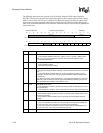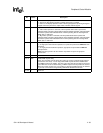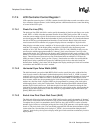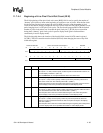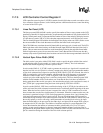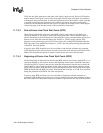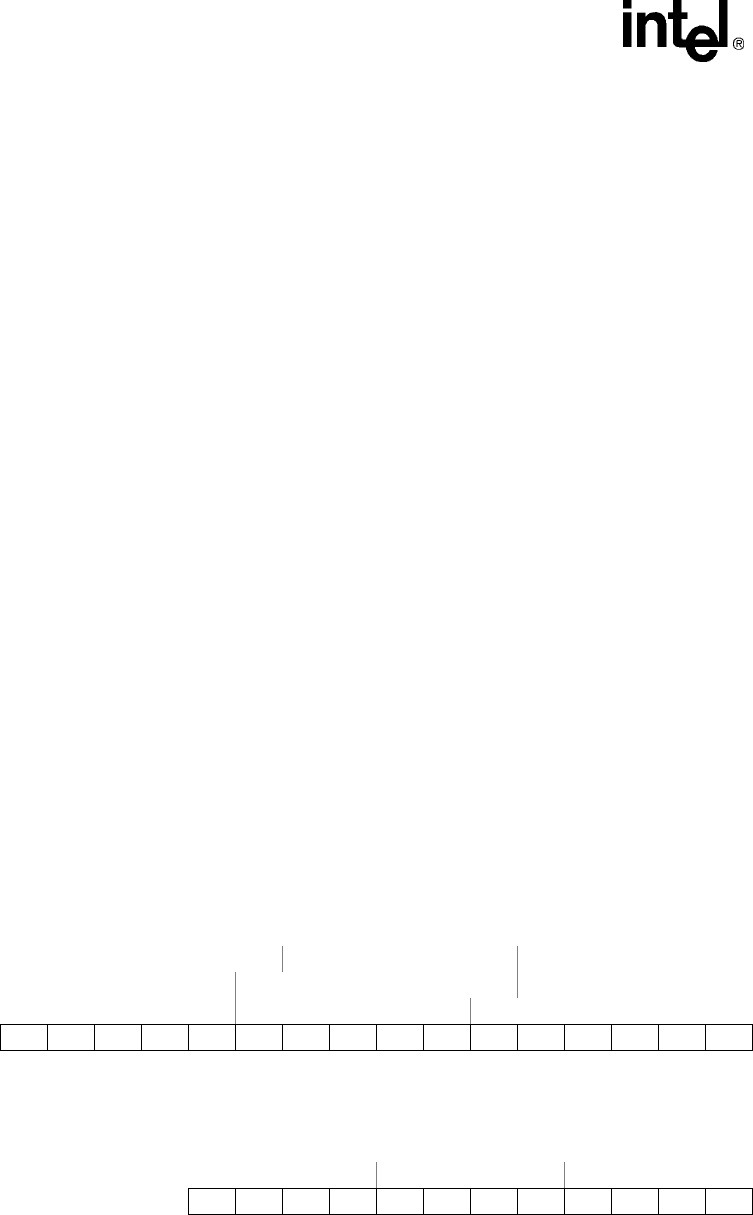
11-30 SA-1100
Developer’s Manual
Peripheral Control Module
Thus two 16-bit values are packed into each word in the frame buffer. Each 16-bit value is transferred
via the DMA from off-chip memory to the input FIFO. Unlike 4- and 8-bit per pixel modes, the 16-bit
value bypasses both the palette and the dither logic, and is placed directly in the output FIFO to be
output on the LCD’s data pins. Increasing the size of the pixel representation allows a total of 64K
colors to be generated. This 16-bit value output to the pins can be organized into one of three RGB
color formats: 6 bits of red, 5 bits of green, and 5 bits of blue data; 5 bits of red, 6 bits of green, and 5
bits of blue data; 5 bits of red, 5 bits of green, and 6 bits of blue data, as specified by the user. Note
that the pin timing of the LCD changes when active mode is selected. Timing of each pin is described
in subsequent bit-field sections for both passive and active mode. Additionally, the LCD controller
can be configured in active color display mode and used with an external DAC and optionally an
external palette to drive a video monitor. Note that only monitors that implement the RGB data format
can be used; the LCD controller does not support the NTSC standard.
Figure 11-9 shows which bits within each frame buffer entry (for 16-bit/pixel mode) and which bits
within a selected palette entry (for 4- and 8-bit/pixel mode) are sent to the individual LCD data
pins. In active mode, GPIO pins 2..9 are also used. Note that the user must configure GPIO pins
2..5 as outputs (for 4- and 8-bit/pixel mode), and GPIO pins 2..9 as outputs (for 16-bit/pixel mode)
by setting the appropriate bits within the GPIO pin direction register (GPDR) and GPIO alternate
function register (GAFR). See the General-Purpose I/O section for configuration information. If
GPDR<6:9> = GAFR<6:9> = 4’hF in 4- or 8-bit/pixel mode, then GPIO<6:9> are pulled low
during LCD operation in active mode. However, the user is free to clear GAFR<6:9>, allowing the
GPIO unit to assume control of these pins to be used as normal digital I/Os. In general, the user
may clear any number of GAFR bits 2..9, to allow the GPIO unit to assume control of unused
GPIO pins for normal digital I/O depending on the required number of data pins.
If the panel that is being controlled contains more data pin inputs than 16, the user may still use the
SA-1100’s LCD controller, but the panel will be limited to a total of 64 K colors. If the user wishes
to maintain the panel’s full range of colors and increase the granularity of the spectrum, the LCD’s
16 data pins should be interfaced to the panel’s most significant R, G, and B pixel data input pins
and the least significant R, G, and B data pins should be tied either high or low. If instead, the user
wishes to maintain the granularity of the spectrum and limit the overall range of colors possible, the
LCD’s 16 data pins should be interfaced to the panel’s least significant R, G, and B pixel data input
pins and the most significant data pins should again be tied either high or low.
Figure 11-9. Frame Buffer/Palette Bits Output to LCD Data Pins in Active Mode
1
GPIO pins 6..0 are grounded by the LCD in this mode. However, if GAFR bit 6..9 are cleared within the system control module,
these pins can be used as normal GPIO pins.
16-Bit/Pixel Mode
Frame Buffer Entry
R<5> R<4> R<3> R<2> R<1> R<0> G<4> G<3> G<2> G<1> G<0> B<4> B<3> B<2> B<1> B<0>
R<4> R<3> R<2> R<1> R<0> G<5> G<4> G<3> G<2> G<1> G<0> B<4> B<3> B<2> B<1> B<0>
R<4> R<3> R<2> R<1> R<0> G<4> G<3> G<2> G<1> G<0> B<5> B<4> B<3> B<2> B<1> B<0>
Bit1514131211109876543210
Data
Pin
GPIO
<9>
GPIO
<8>
GPIO
<7>
GPIO
<6>
GPIO
<5>
GPIO
<4>
GPIO
<3>
GPIO
<2>
LDD
<7>
LDD
<6>
LDD
<5>
LDD
<4>
LDD
<3>
LDD
<2>
LDD
<1>
LDD
<0>
4- or 8-Bit/Pixel Mode
Selected Palette Entry
R<3> R<2> R<1> R<0> G<3> G<2> G<1> G<0> B<3> B<2> B<1> B<0>
Bit VSS
1
VSSVSSVSS11109876543210
Data
Pin
GPIO
<9>
GPIO
<8>
GPIO
<7>
GPIO
<6>
GPIO
<5>
GPIO
<4>
GPIO
<3>
GPIO
<2>
LDD
<7>
LDD
<6>
LDD
<5>
LDD
<4>
LDD
<3>
LDD
<2>
LDD
<1>
LDD
<0>



